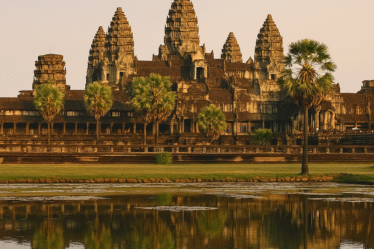Luzon’s area is 104,688 square kilometers, making it the world’s 17th largest island. It is the fourth most populated island in the world. Located on Luzon are the country’s capital, Manila, and its most populated city, Quezon City. The island is very mountainous and is home to Mount Pulag, the third highest mountain in the country and Mount Pinatubo, Mayon, and Taal Volcano, Luzon’s most famous volcanoes. To the west of Luzon island is the South China Sea (Luzon Sea in Philippine territorial waters), to the east is the Philippine Sea, and to the north is Luzon Strait containing Babuyan Channel and Balintang Channel.
The main part of the island is roughly rectangular in shape and has the long Bicol Peninsula protruding to the southeast. The northern part of the island contains the large mountain range, the Cordillera Central which is covered in a mixture of Luzon tropical pine forests and Luzon montane rain forests. Mount Pulag, the highest mountain in Luzon is located here, rising 2,922 meters.
To the east of the Cordillera Central is the large Cagayan Valley, which serves as the basin for the Cagayan River, the longest river in the Philippines. To the east of the valley rises the Sierra Madre mountain range, easily the longest range in the country.
The Sierra Madre snakes southwards into the central and southern part of the island. Between it and the Zambales Mountains to the west is the largest plain, the Central Luzon plain. This plain, approximately 11,000 km² in size, is the country’s largest producer of rice. Among the rivers irrigating this plain, the longest are Cagayan to the north, and Pampanga to the south. In the middle of the plain rises the solitary Mount Arayat. To the west, in the Zambales Mountains, rises Mount Pinatubo, made famous because of its enormous 1991 eruption.
The Zambales mountains extends to the sea in the north, forming Lingayen Gulf, home to the Hundred Islands National Park. To the south, the mountains also extend into the sea, forming the Bataan Peninsula, which encloses the Manila Bay. This natural harbor is considered to be one of the best natural ports in East Asia, due to its size and strategic geographical location.
To the southeast of Manila Bay is the largest lake in the country, and also the largest inland lake in Southeast Asia, the Laguna de Bay (Old Spanish, Lake of Bay town). This 949 km² lake is drained by the Pasig River into Manila Bay. Pasig River is one of the most important rivers in the country due to its historical significance and because it runs through the center of Metro Manila.
Located just 20 km southwest of Laguna de Bay is Taal Lake, within the southwestern portion of the island. This caldera of a lake contains the smallest volcano of the country, Taal Volcano, which rises on the island in the center of the lake. The volcano in turn has a lake in its crater. All the surrounding areas of Taal Lake were once part of a massive prehistoric volcano that covered the southern portion of the province of Cavite, Tagaytay City, and the whole of Batangas province.
Off the southwestern portion of Luzon is the island of Mindoro, separated by the Verde Island Passages. The passages connect the South China Sea to the east with the Tayabas Bay. To the south of the bay is the island of Marinduque.
The southeastern portion of Luzon is dominated by the Bicol Peninsula. This is a mountainous and narrow region that extends approximately 150 km southeast. Along it are numerous gulfs and bays. In the north is Lamon Bay, which contains Alabat Island and is south of the Polillo Islands of Quezon province. Other bays and gulfs include San Miguel Bay, Lagonoy Gulf, Ragay Gulf, and Sorsogon Bay.
To the east of the peninsula lies the island of Catanduanes. Leading to it is the Caramoan Peninsula. Off the southeast tip of Bicol is Samar island, separated by San Bernardino Strait. Bicol Peninsula is connected to the main part of Luzon through the Tayabas Isthmus. Extending south from the isthmus is the Bondoc Peninsula.
The Bicol Peninsula is also home to numerous volcanoes. The most famous is Mayon Volcano in Albay. This 2,460 m high volcano is symmetrically shaped, rivaling that of Mount Fuji in Japan, and is a symbol of the Bicol Region. Other notable mountains are Mount Isarog and Mount Iriga in Camarines Sur, and Mount Bulusan in Sorsogon.
Located off the southwestern coast of the Bicol Peninsula are the islands of Ticao, Burias, and Masbate
